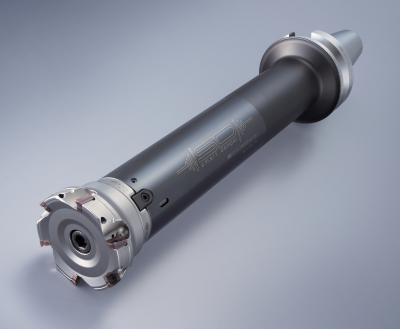
BIG KAISER has expanded its lineup of Smart Damper-equipped, arbor-style face mill holders. This new holder is the largest and longest milling tool BIG KAISER has offered yet. It supports face mills with diameters of 3", 4", 80mm or 100mm with an arbor pilot diameter of either 1" or 27mm.
The Model SDF57 assembly has an outside diameter of 2.83" and allows users of 3" face mills to access up to 19.68" of reach, the longest tool assembly in the industry using standard components. Face milling components used in construction equipment, aerospace and oil/gas industries will see the most opportunity for this new tool holder with vibration dampening, where long reaches are common.
Smart Damper enables quiet, vibration-free milling, even in long-projection assemblies. The integral design of Smart Damper shortens the distance from the damping mechanism to the cutting edge. This produces higher damping effects to the tool assembly, minimizing chatter or vibration for better surface finishes and improved metal removal rates.
The new Smart Damper face mill holder is available for BBT50, BCV50 and HSK-A100 shank styles.
Contact Details
Related Glossary Terms
- arbor
arbor
Shaft used for rotary support in machining applications. In grinding, the spindle for mounting the wheel; in milling and other cutting operations, the shaft for mounting the cutter.
- chatter
chatter
Condition of vibration involving the machine, workpiece and cutting tool. Once this condition arises, it is often self-sustaining until the problem is corrected. Chatter can be identified when lines or grooves appear at regular intervals in the workpiece. These lines or grooves are caused by the teeth of the cutter as they vibrate in and out of the workpiece and their spacing depends on the frequency of vibration.
- gang cutting ( milling)
gang cutting ( milling)
Machining with several cutters mounted on a single arbor, generally for simultaneous cutting.
- milling
milling
Machining operation in which metal or other material is removed by applying power to a rotating cutter. In vertical milling, the cutting tool is mounted vertically on the spindle. In horizontal milling, the cutting tool is mounted horizontally, either directly on the spindle or on an arbor. Horizontal milling is further broken down into conventional milling, where the cutter rotates opposite the direction of feed, or “up” into the workpiece; and climb milling, where the cutter rotates in the direction of feed, or “down” into the workpiece. Milling operations include plane or surface milling, endmilling, facemilling, angle milling, form milling and profiling.
- milling machine ( mill)
milling machine ( mill)
Runs endmills and arbor-mounted milling cutters. Features include a head with a spindle that drives the cutters; a column, knee and table that provide motion in the three Cartesian axes; and a base that supports the components and houses the cutting-fluid pump and reservoir. The work is mounted on the table and fed into the rotating cutter or endmill to accomplish the milling steps; vertical milling machines also feed endmills into the work by means of a spindle-mounted quill. Models range from small manual machines to big bed-type and duplex mills. All take one of three basic forms: vertical, horizontal or convertible horizontal/vertical. Vertical machines may be knee-type (the table is mounted on a knee that can be elevated) or bed-type (the table is securely supported and only moves horizontally). In general, horizontal machines are bigger and more powerful, while vertical machines are lighter but more versatile and easier to set up and operate.
- shank
shank
Main body of a tool; the portion of a drill or similar end-held tool that fits into a collet, chuck or similar mounting device.

